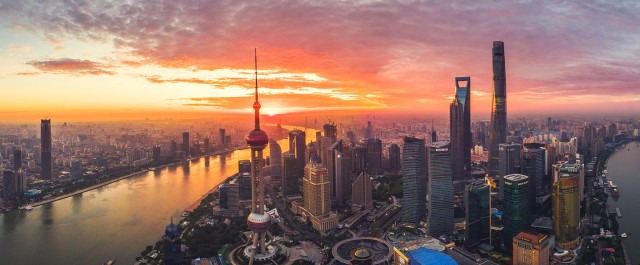Shanghai
SHANGHAI IS CHINA's “second city,” and is a leader in the economic transformation of 21st-century China. Developed in the 19th century as imperial China's main outlet to the West, the city became one of the world's greatest marketplaces, as well as a sophisticated cultural center known as the Paris of the east. But it has also been labeled the New York of the east, as a city that rivals its national capital in importance in everything from population to economic power to cultural dominance. But the city is best known today as the dragon head, owing to its position at the mouth of China's greatest river, and as the driving force for China's economy.
Shanghai—meaning “on the sea”—is located where the Yangzi Rover (CHANGJIANG) meets the East China Sea. Though not actually located on the sea, the city's location about 10 mi (16 km) up the Huangpu River shield it from the more dangerous waters of the mouth of the Yangzi (about 25 to 30 mi or 40 to 50 km), subject to floods and high winds. The 37-mi (60-km) waterfront along the banks of the Huangpu sees about one-fourth of all of China's oceangoing cargo, most still carried locally by traditional sailing junks (fanchuan). The Yangzi is China's main east-west artery, navigable as far as Chongqing, 3,900 mi (6,290 km) upstream.

Control of this area meant control of most of China, a fact well known for centuries by waves of imperial dynasties, followed by European colonialists in the 19th century and Chinese Nationalists, Japanese occupiers, and the Communist Red Army in the 20th century. The British capture of the Yangzi delta in 1842 forced China's government to open its first port to Western traders. Communist occupation of the region in 1949 spelled the end of Nationalist government on the mainland.
Returning to its roots, Shanghai was one of the first Chinese cities opened for foreign investment in 1984, and the adjacent city of Pudong became one of six Special Economic Zones, with relaxed import/export regulations and lower taxes, in 1993.
With Jiangsu Province to the north and Zhejiang to the south, Shanghai and the surrounding countryside forms its own district, one of China's four shi (or municipalities), equivalent in administrative status to a pro-vince. The largest city in China, the district's 2,473 square mi (6,314 square km) is home to nearly 14 million people, making it the 16th-largest metro area in the world. The city proper ranks at number 11, with 9.1 million inhabitants. Shanghai's population density is about five times that of Beijing. Too many people and too many factories are causing this city built on a marshy delta to slowly sink into the sea, so efforts are being made to pump water back into the soil and to redistribute a lot of its people and industries more evenly around the region, specifically in Pudong, east of the Huangpu.
Shanghai has been a market town for centuries, officially recognized as an imperial city in 1159. In the 18th century it grew rapidly as the center of the Chinese cotton and fabric industries. Until World War II, Shanghai was divided into Old Shanghai (around the districts of Nantao, or Nanshi, and Chapei), and the International Settlement. The International Settlement was an essentially self-governing enclave of European commercial colonies, separate from the Chinese city (physically, by a moat), with its own schools, municipal officers, and police systems. Many older residents who were raised and educated in this sector still speak English or French and practice Christianity.
One of the most recognizable sights in East Asia is the commercial strip along the Huangpu known as the Bund (now called Zhong Shan Road), which resembles Liverpool, England, more than it does any other Asian waterfront. The British were the first to establish trade here in the 1840s, followed by factories from the 1890s. Over half of pre-World War II Chinese industry and nearly all of its banks were located in and around Shanghai. The Nationalist Chinese government began to develop the Chinese part of Shanghai into a model city during the 1930s, with new municipal buildings, libraries, museums, and medical centers. The Japanese invasion and occupation from 1937 put a stop to this growth, and the war devastated much of the region's trade and industry.
The city is strategically located between China's north and south and retains strong ties to the Chinese diaspora across the Pacific Rim. These advantages naturally stimulated Shanghai's economic boom since the loosening of central government control in the early 1990s. Shanghai now boasts the highest concentration of educated workers, especially in science, technology, and management. Local industry focuses on automobiles, iron and steel, petrochemicals, power equipment, telecommunication,s and electrical appliances. Nearly $17 billion in foreign investment has transformed it into a glittering city of skyscrapers, but problems remain in the growing disparity between rich and poor and in the still-heavy government regulations emanating from Beijing.